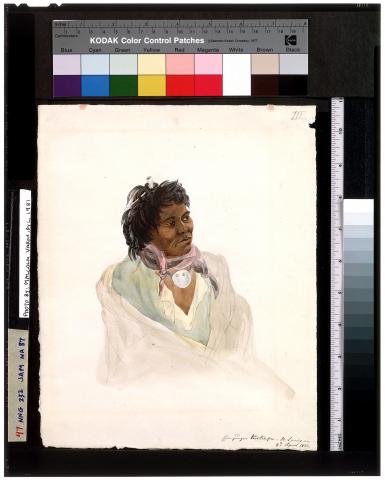April 10, 1833
On 10 April at 10:30 in the morning, the steam engine on the Yellow Stone was started after the groupM1Apart from us, it included Mr. Chouteau and several ladies, Messrs. Sanford and Pilcher, and several employees of the company, whom Messrs. McKenzie and Dougherty later joined. had assembled on board.M2At 7:30, 12 3/4°R [60.7°F, 15.9°C]; noon, 17 1/2°R [71.4°F, 21.9°C]. Mr. Chouteau, his daughters, and other 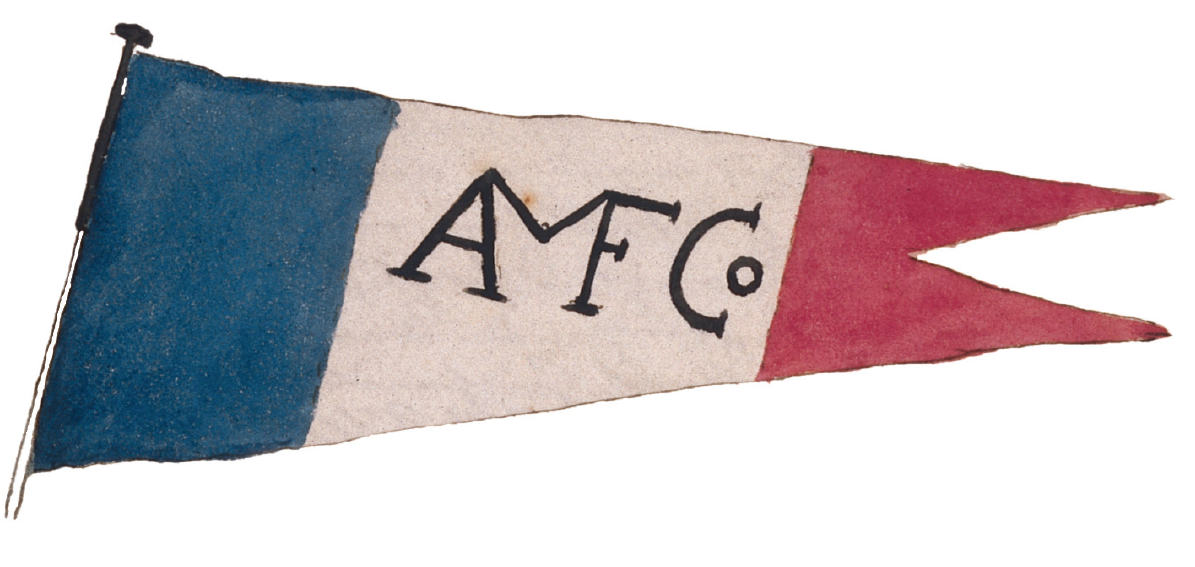 ladies accompanied us on the journey today. The Yellow Stone’ s flags were fluttering, the American one aft and a narrower one forward, as depicted here, with the initials of the American Fur Company. Several cannon shots had been fired, whereupon the residents of St. Louis assembled en masse. The Sauk and IowaysM3The Sauks live beside the Iowas near the Missouri [River], not far from Fort Leavenworth. According to Dougherty, they are said to speak an entirely different language from that of the Iowas, from whom they otherwise cannot be distinguished in dress and external appearance. The Americans pronounce this name “Ayaway” or “Ayawä,” but they write “Ioway,” something that can easily confuse foreigners. See the language samples of the Iowas on [manuscript] page 29. Kickapoo Indians in their original attire, weapons in hand, stood and sat on the bank. Mr. Bodmer sketched several of the former and the women of the latter as well as the four canoes of the former, which were fastened to each other when they came down the Missouri. These canoes are long and narrow, with a curved beak fore and aft. At least twenty Canadians (engagés, 2 or trappers), some of them drunk, were sitting above on the deck of our ship; they fired a running volley from their muskets and rifles simultaneously with the frequently discharged cannon. In the meantime, one saw the Sauks leaving in procession to attend a council council with General Clark, with their interpreter, an old Frenchman, in the lead.M4The men are Sauks, the women Kickapoos.
ladies accompanied us on the journey today. The Yellow Stone’ s flags were fluttering, the American one aft and a narrower one forward, as depicted here, with the initials of the American Fur Company. Several cannon shots had been fired, whereupon the residents of St. Louis assembled en masse. The Sauk and IowaysM3The Sauks live beside the Iowas near the Missouri [River], not far from Fort Leavenworth. According to Dougherty, they are said to speak an entirely different language from that of the Iowas, from whom they otherwise cannot be distinguished in dress and external appearance. The Americans pronounce this name “Ayaway” or “Ayawä,” but they write “Ioway,” something that can easily confuse foreigners. See the language samples of the Iowas on [manuscript] page 29. Kickapoo Indians in their original attire, weapons in hand, stood and sat on the bank. Mr. Bodmer sketched several of the former and the women of the latter as well as the four canoes of the former, which were fastened to each other when they came down the Missouri. These canoes are long and narrow, with a curved beak fore and aft. At least twenty Canadians (engagés, 2 or trappers), some of them drunk, were sitting above on the deck of our ship; they fired a running volley from their muskets and rifles simultaneously with the frequently discharged cannon. In the meantime, one saw the Sauks leaving in procession to attend a council council with General Clark, with their interpreter, an old Frenchman, in the lead.M4The men are Sauks, the women Kickapoos.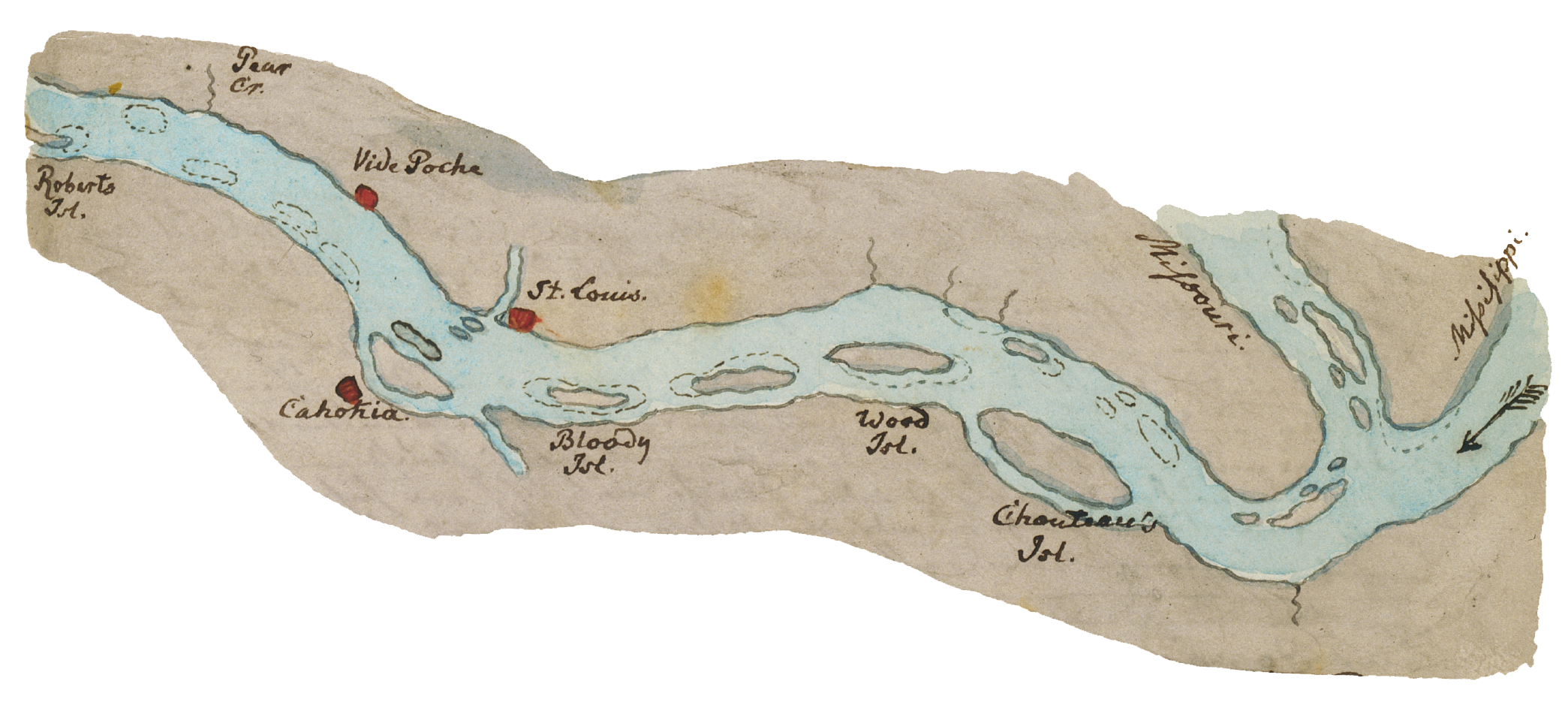
 At the bank the steamboats Halcyon, Illinois, Utility, Clinton, John Nelson, Paragon[Page 2:2] (on which we had arrived), Dove, S. Jaques [sic], and Wm. Parson lay at anchor. During the volley for our departure, the ship was started, and we quickly sailed past the city; a crowd of persons greeted us and jubilantly shouted a farewell. Messrs. McKenzie and Dougherty stayed behind today.
At the bank the steamboats Halcyon, Illinois, Utility, Clinton, John Nelson, Paragon[Page 2:2] (on which we had arrived), Dove, S. Jaques [sic], and Wm. Parson lay at anchor. During the volley for our departure, the ship was started, and we quickly sailed past the city; a crowd of persons greeted us and jubilantly shouted a farewell. Messrs. McKenzie and Dougherty stayed behind today.
Above the city, the steep, stratified limestone bank immediately begins again; we pass close to it. The other bank is without rocks, rather low, with cottonwood forests just turning green. A boat with a wide, torn sail passes.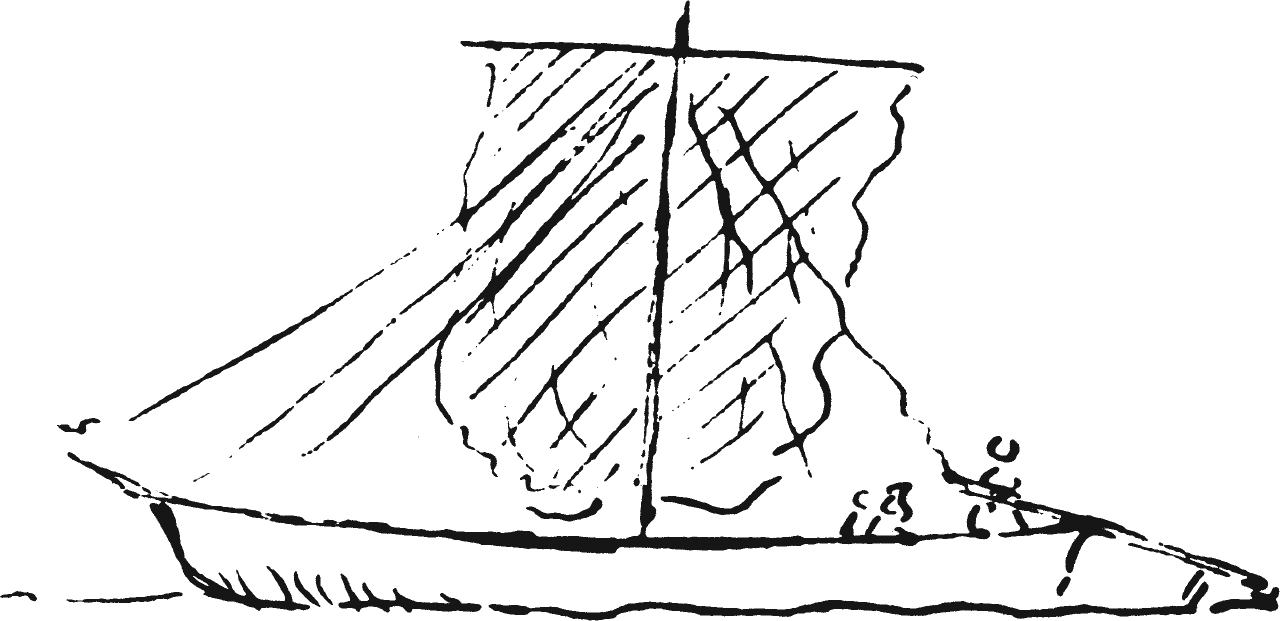
The river forms a broad, brownish gray expanse. Beyond St. Louis, individual dwellings, factories, and the like—mostly constructed from local whitish sand limestone—appear along the western bank. Green thickets already along the bank. Much wood, branches, and shavings drift past in the Mississippi.M5The name of this large stream is derived from the language of the Ojibwe and related tribes. Earlier French travelers named it not Mississippi but Mechasippi. Gradually the name was changed, but originally it was called Meschisipo in the Ojibwe language (Sipo, “river,” and Meschi, “large”). Several sandbars. Farther on, cottonwoods along the left bank; before them, borders of willows, which already appear in their light-green color. Deposits of driftwood.
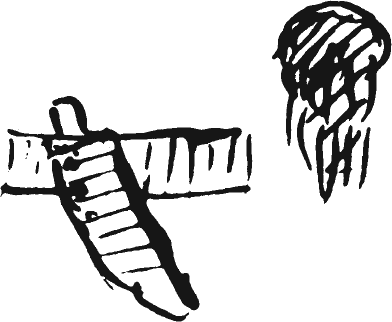 The drunken engagés, or trappers, continued making a lot of noise; they shouted, fired their guns, drank. They are just as coarse as the Indians [and] speak French; some are half-breed Indians and dark brown. One such small fellow was very unpleasant; on his back he carried an Indian scalp, stretched on a circular frame. All of them keep their big scalping knives in a sheath on a belt on their backs.
The drunken engagés, or trappers, continued making a lot of noise; they shouted, fired their guns, drank. They are just as coarse as the Indians [and] speak French; some are half-breed Indians and dark brown. One such small fellow was very unpleasant; on his back he carried an Indian scalp, stretched on a circular frame. All of them keep their big scalping knives in a sheath on a belt on their backs.
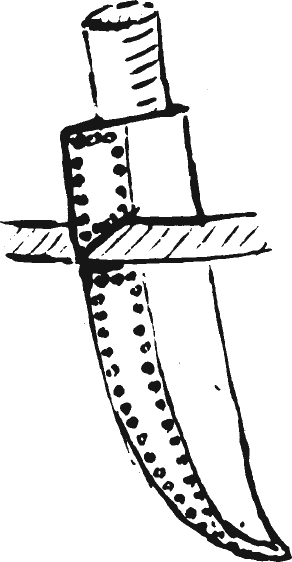 At eleven o’clock we had a small creek to the left. On the Illinois bank [is a] tall forest with high white Platanus. It, too, is turning green; the understory is even greener. In the river, a large, broad island with tall forest with a fringe of willows before it. To the left we reach the clearing with a view of Major O’Fallon’s house. Steep bank to the left, with forest; we follow the channel to the left. On the bank [are] strata, alternately of clay and sand. Near the end of the big island, a smaller one lies. In the forest along the left bank, tall Platanus wildly entangled by vines. Board rafts move past. At midday, groups of three and four turtles, undoubtedly the geographica, sun themselves on trunks lying along the bank. Tall cottonwoods or aspens blossom in the forest. A small Podiceps, apparently with a mottled beak, is swimming 20 paces away and does not fly up. Thus we sail along close to the bank.M6Chouteau’s Island.
At eleven o’clock we had a small creek to the left. On the Illinois bank [is a] tall forest with high white Platanus. It, too, is turning green; the understory is even greener. In the river, a large, broad island with tall forest with a fringe of willows before it. To the left we reach the clearing with a view of Major O’Fallon’s house. Steep bank to the left, with forest; we follow the channel to the left. On the bank [are] strata, alternately of clay and sand. Near the end of the big island, a smaller one lies. In the forest along the left bank, tall Platanus wildly entangled by vines. Board rafts move past. At midday, groups of three and four turtles, undoubtedly the geographica, sun themselves on trunks lying along the bank. Tall cottonwoods or aspens blossom in the forest. A small Podiceps, apparently with a mottled beak, is swimming 20 paces away and does not fly up. Thus we sail along close to the bank.M6Chouteau’s Island.
The spicewood [— —] had almost finished blooming; its leaves are breaking out. A pretty yellow viola blooms in the dry foliage in the sparse areas of the forest. The redbud (Cercis), covered with its pretty little flowers. The heat in the forest was very great. The maples had small leaves. The upright catkins of the cottonwoods were just beginning to open. There was a small log house here, and much and much firewood was piled up. A large group of persons set to work and loaded much wood, and soon we hastened on. Before us to the left, a headland; beside it, two river outlets. Near the first of these, a stand of tall trees on a low expanse of willows; beyond it lies the wooded promontory that divides the Missouri from the Mississippi. On the latter, somewhat to the right, an island, and in the background one sees the white houses of the town [of] Holton.
In the river one now notices the very striking distinction between the water of the Missouri and that of the Mississippi: the former is clear and green yellow-brownish and murky; the latter, clear and greenish. The green water skirts the Illinois bank, but the yellowish water makes up the remaining broader part. Before the wooded headland dividing the two rivers are narrow sandbars with snags and driftwood. Here I saw a Carbo, which had been sitting on a trunk near the bank, fly off. At the junction of the Missouri and Mississippi,M7Entering the Missouri on 10 April at noon. a strong wind prevailed. We turn into the Missouri, which is about as wide here as the upper Mississippi. The island remains to our right; we see Holton behind it. Large deposits of driftwood to the left along the bank. Our Canadians fire some shots to greet the Missouri. On the bank to the right, tall forest, all of which already has a pleasantly green tinge. A sandbar with much driftwood remains to our right; likewise on the left bank. Navigation is very dangerous on the Missouri: on both sides, large piles of trunks in the water leave us only a narrow channel. The bank, steeply eroded, continues to cave in, and big tree trunks constantly produce new snags. To the right, an island with a border of tall cottonwoods; behind them, the forest in delicate, fresh green.
Before us, on a gradually sloping, uniform ridge, we see Bellefontaine, formerly a military post for protection against the hostile Indians here. M8Bellefontaine on the southern bank.A two-story  building and several smaller ones are visible from a distance against the sky. Urubus (turkey buzzards) fly above the forest. To the right, an island, nearby sandbars; on the island, willows and some forest. To the left, [a] steeply eroded bank; the forest [has a] pleasant, light-green color. The character of the Missouri in its lower regions is just like that of the Mississippi. Several species of oak with long catkins are blooming. Young stems of Cercis canadensis, fallen from the tall bank, stand upright in the water and continue to bloom. As we pass close to Bellefontaine, we notice that three or four of the buildings there are dilapidated and empty; in a ravine above, a small run flows behind them past them and falls into the Missouri as a waterfall. Beyond the creek is a wooded hill all reddened from the blossoms of the delightful redbud; likewise on the bank. It is a characteristic feature of North America that most trees bloom before they produce leaves: for example, oak, cottonwoods, walnuts, hazel, dogwood, redbud, Prunus, Cerasus, and other species.
building and several smaller ones are visible from a distance against the sky. Urubus (turkey buzzards) fly above the forest. To the right, an island, nearby sandbars; on the island, willows and some forest. To the left, [a] steeply eroded bank; the forest [has a] pleasant, light-green color. The character of the Missouri in its lower regions is just like that of the Mississippi. Several species of oak with long catkins are blooming. Young stems of Cercis canadensis, fallen from the tall bank, stand upright in the water and continue to bloom. As we pass close to Bellefontaine, we notice that three or four of the buildings there are dilapidated and empty; in a ravine above, a small run flows behind them past them and falls into the Missouri as a waterfall. Beyond the creek is a wooded hill all reddened from the blossoms of the delightful redbud; likewise on the bank. It is a characteristic feature of North America that most trees bloom before they produce leaves: for example, oak, cottonwoods, walnuts, hazel, dogwood, redbud, Prunus, Cerasus, and other species.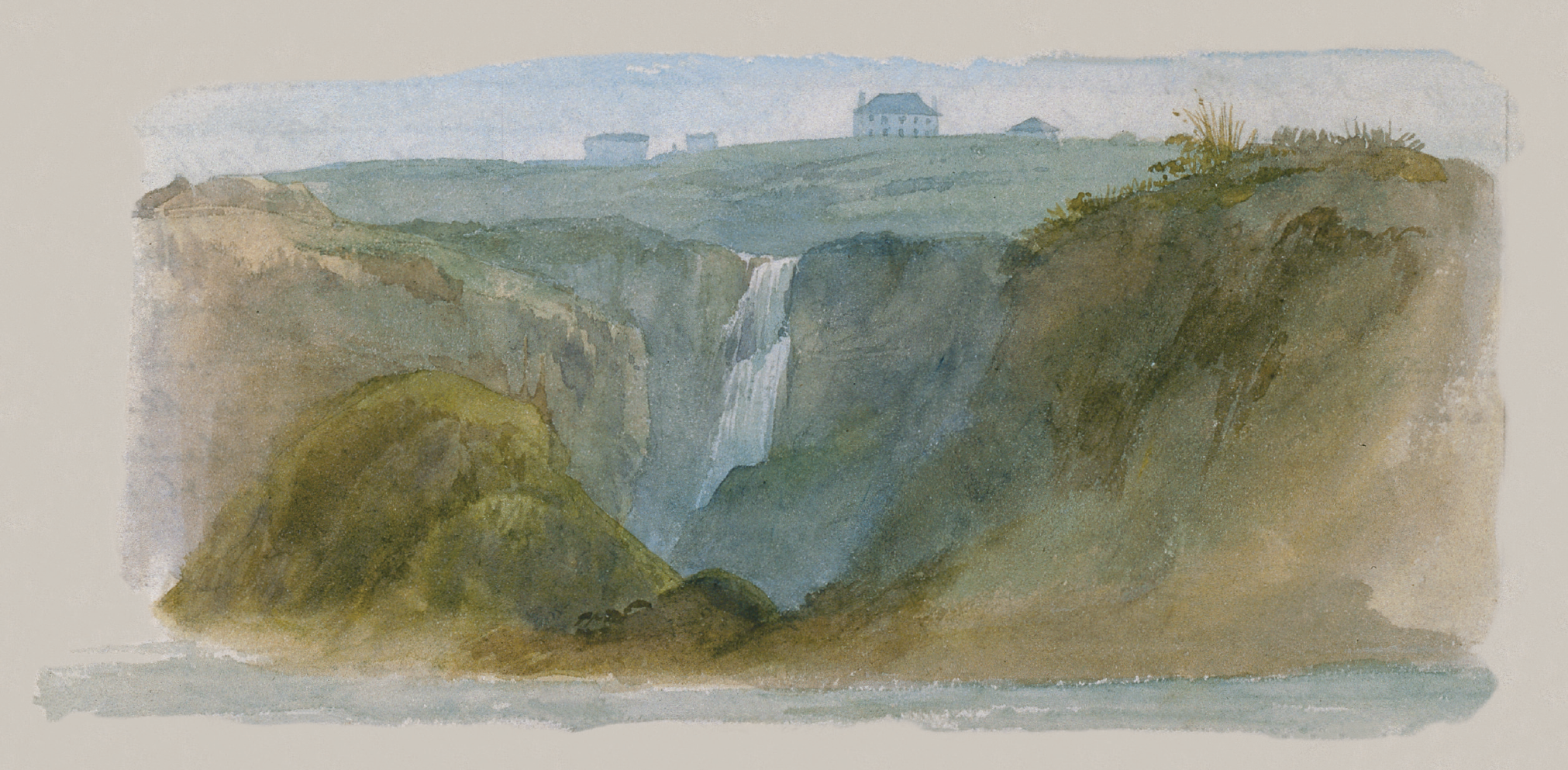
Farther on, a small creek to the left with high banks; on the other side is a flat sandy island with willow and cottonwood. Tall, white Platanus in the forest. To the left rises a chain of limestone hills with isolated rock clusters; here a snow-white bush [— —] is blooming on and among the limestone rocks. Hills on the left bank slightly rounded off with ravines quite regularly  between them, all of them covered with sparse forests. The rock-tower formations of the Mississippi also resume here. There are many holes in these rocks, as along the Mississippi; the dwarf tree with white blossoms, as though covered with snow, grows everywhere among the rocks. Unusual rock banks on the shore; driftwood lying on top of them. A 5-foot-long black snake (Coluber constrictor [constrictor]) tried to crawl up the rock bank but fell tail-first down again.
between them, all of them covered with sparse forests. The rock-tower formations of the Mississippi also resume here. There are many holes in these rocks, as along the Mississippi; the dwarf tree with white blossoms, as though covered with snow, grows everywhere among the rocks. Unusual rock banks on the shore; driftwood lying on top of them. A 5-foot-long black snake (Coluber constrictor [constrictor]) tried to crawl up the rock bank but fell tail-first down again.
We move along the right bank, 1 1/2 or 2 miles. The village Portage des Sioux is on the other side above the small spit of land on the Mississippi. The Indian agent Sanford told us about Prince Paul of Württemberg, who twice made the journey up the Missouri. He has published an account of his first journey with lithographed plates—that is, [a book] just for his friends. He is said to have lied terribly and to have spent very much money. To the left, a willow island, which is not yet six to eight years old. Islands are often formed here: first trees, thereupon sand, willows, and cottonwoods in five or six years. Here Sanford told us about the various kinds of Indian tobacco. According to him, all the eastern and southern nations smoke sumac leaves, but the Blackfoot smoke a different plant: the gray willow, the [— —]. Beautiful view of the redbud to the right in the forest; to the left, large, flat sandbars and islands. On the right bank we saw several men near a firmly anchored fishing rod, which they lifted up and pulled in a big fish. Soon afterward to the right, a flat sandy island with willows. Their very long, slender roots hang down freely from the steep bank. A sounding is taken.
Shortly before sundown, dreary, misty atmosphere. Before us, islands with various gradations and shades of light. The tall, white Platanus are purple in the evening light. On the sandbars to the right, deposits of wood. To the right, another sandy island with a pointed tip. They are mostly formed in this manner: pointed at the ends with banks 8 to 10 feet high [and] young willows on top. These are 6 to 15 feet high, as slender as whips, with foliage only on top, since they grow crowded together. Rushes (Equisetum [sp.]) grow among them but only in a few places. Before us, two islands again; the one to the right is wooded. To the left, another, [a] sandbar; at their upstream tips as well as along the banks, large deposits of driftwood. A kingfisher (Alcedo alcyon) is perched on a cottonwood on an island, ruffles its crest, and flips its tail up. A small Podiceps flies past. Earlier we had seen coots (Fulica) swimming in the river; they had just returned from migration.
The river soon makes a sharp turn to the left. Magnificent red sun before sundown; the horizon always hazy in this country. The sun’s reflection in the water is blood-red, indescribably beautiful. About a mile farther, a recently sunken steamboat steamboat is located on the left bank. A large group of people have built huts here, probably to salvage as much as possible from the wreck. In the inland areas, individual, completely green trees appear in the distance; behind them the entire understory is purple from Cercis blossoms. Settlements to the left, where the trees are already very green. In the evening we put in at the bank.

